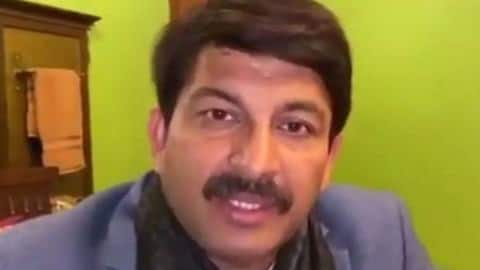In a first, BJP leader used AI-generated videos during campaigning
What's the story
Ahead of the Legislative Assembly elections in National Capital, BJP Delhi President Manoj Tiwari used AI-generated deepfake videos while campaigning.
The Bhojpuri actor-turned-politician used the controversial technology to turn a video of him speaking something totally different into a campaign monologue, criticizing his political rival Arvind Kejriwal.
Here's all you need to know about it.
Deepfakes
First, a quick recap on what deepfakes are
Synthesized with deep neural networks, deepfakes are clips that show the face of one person in another one's video.
The videos are created with so realism that one can easily make a person, be it a celebrity or politician, say something that they wouldn't normally do.
The system also works on audio files where spoken words can be replaced with something completely unrelated.
Issue
Speech on NRC transformed into campaign video
In this case, Vice reports, Tiwari used the deepfake tech to transform one of his speeches on NRC into campaign videos criticizing Kejriwal.
"[Kejriwal] cheated us on the basis of promises. But now Delhi has a chance to change it all. Press the lotus button on February 8 to form the Modi-led government," Tiwari can be seen saying in one of the fabricated clips.
Realism
Clips made in multiple languages, with complete realism
While both deepfake videos show Tiwari at the same location as that used in the original, his speech content, voice, and lip-movement have been modified to such realism that one easily consider the videos real.
Also, in the original clip, he speaks in Hindi, but the fabricated ones show him speaking in English and Haryanvi - a move clearly aimed at reaching more voters.
Company
Company created these videos to scale up Tiwari's campaign
Tiwari's deepfakes have been created by The Ideaz Factory, a political communications firm that BJP had partnered with for creating "positive campaigns" to reach voters speaking different languages.
"We used a 'lip-sync' deepfake algorithm and trained it with speeches of Manoj Tiwari to translate audio sounds into basic mouth shapes," Sagar Vishnoi of The Ideaz Factory said while detailing their video-fabrication technique.
Reach
These clips reached over 15 million people
The fake clips, largely aimed at dissuading Haryanvi-speaking migrants from voting for Kejriwal's party, were distributed across more than 5,000 WhatsApp groups in Delhi NCR, reaching as many as 15 million people.
"The Haryanvi videos let us convincingly approach the target audience even if the candidate didn't speak the language of the voter," Neelkant Bakshi, the co-in-charge of IT for BJP Delhi, told Vice.
Effect
This shows how deepfakes can be used to mislead people
Even though Tiwari's video was part of a campaign and completely innocuous, the realism of the clip shows how effectively deepfake tech can alter videos to spread misinformation and mislead people.
Today, we are at a stage when any tech-savvy person can use this tech to fabricate a celebrity/politician's video and make them say something controversial, which could turn the public against them.
Information
Due to this, actions have been taken against deepfakes
Due to the risk of this tech, unlabelled deepfakes have been banned in China and select parts of the US. Even social media platforms like Reddit, Twitter, and Facebook have announced plans to prevent the spread of videos impersonating someone else.
